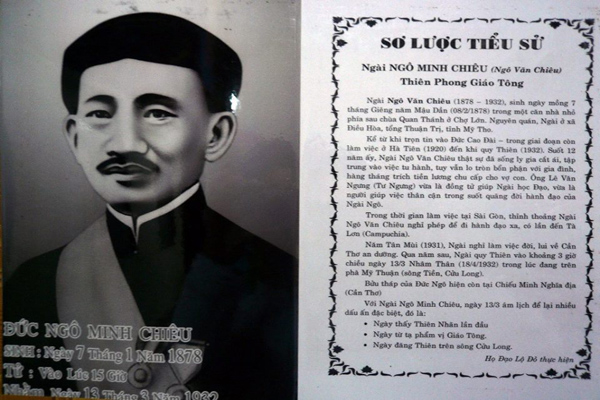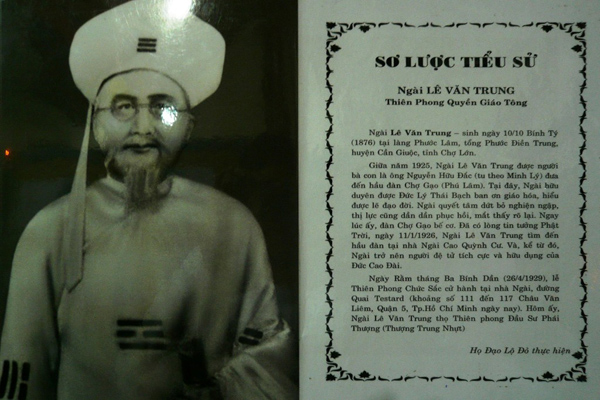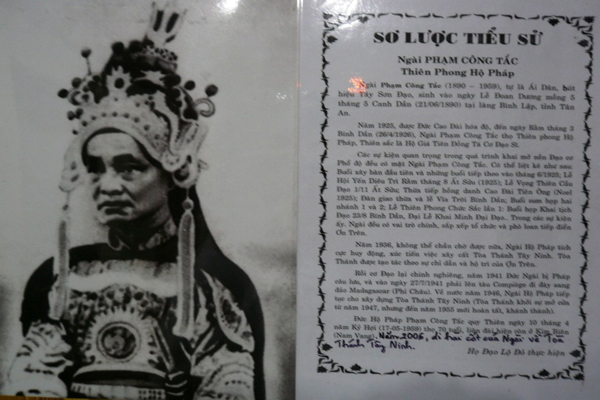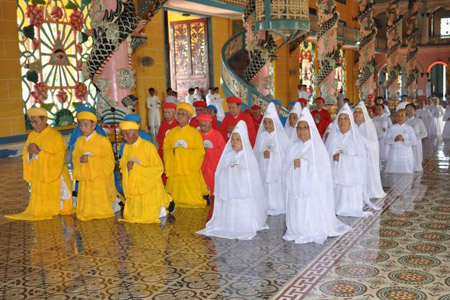Throughout the history of Caodaism, some figures have been considered co-founders such as Ngo Van Chieu, Le Van Trung, Pham Cong Tac, Vuong Quan Ky and Cao Quynh Cu.
Ngo Van Chieu (also known as Ngo Minh Chieu) was born in 1878 in Binh Tay, Cho Lon, Sai Gon (present-day Ho Chi Minh City) into an impoverished mandarin family of the Nguyen Dynasty in Hue. It is recorded in the history of Caodaism that, he could not suck and swallow milk from his mother's breast when he was a newborn. Instead, he had to eat rice soup. Growing up, he received an excellent education. He became the Secretary of Immigration Service in Sai Gon after graduating from Chasseloup-Laubat College. In 1902, he was appointed the Chief of Phu Quoc District. He had a passionate interest in fantasy stories and necromancy (conjuring up dead persons' souls and inviting them to pass on a message to the living through a medium). In Phu Quoc he was often found engrossed in fantastical thoughts. In 1921, he started to worship the Divine Eye-a symbol of Caodaism. This means that Ngo Van Chieu practiced Caodaism before it was founded. In 1924, he moved to work at the South Vietnam Office of Governor. Here he quickly picked up spiritism. He often discussed it with his friends. He also established a group called Chieu Ky, in which he and Vuong Quan Ky played decisive roles. In his words, a spirit called Cao Dai Tien Ong had appeared to him and given him a mission to build a new religion in the South of Vietnam. Then he informed his friends of his meeting with the Supreme Being of Caodaism and received wholehearted support from them, especially Le Van Trung and Pham Cong Tac. However, in late 1926, when Caodaism was developing strongly, Ngo Van Chieu gave up the position as a leader of this religion to return to Can Tho for further practice. The cult of Caodaism was then organized under the leadership of Le Van Trung. In Can Tho, he founded a Caodaist sect called Cao Dai Chieu Minh Tam Thanh Vo Vi. He died there in 1933.

Le Van Trung was born in 1875 to a shopkeeper in Cho Lon. He was smart and studious. After graduating from Chasseloup- Laubat College in 1893, he was appointed the Secretary at the South Vietnam Office of Governer. He was assigned to take charge of public works and markets. In 1905, he left to work as a contractor on the railways. He was very successful in his new job and was subsequently elected to the Senate of Indochina and later the General Advisory Board of Indochina. In 1920, he suffered severe financial setbacks and went bankrupt in 1924. After his failure in business, he turned to religious activities. Thanks to his good diplomatic and organizational skills, he quickly took over Ngo Van Chieu's mission to convert people to this new religion. Later, he became one of the founders of Caodaism and the chief of Cuu Trung Dai -the executive body of Caodaism. He died in the Tay Ninh Holy See in 1934.

Pham Cong Tac was born in 1893 to a Catholic family in Tay Ninh. He also studied at Chasseloup-Laubat College. He worked in the Tax Service in 1910 and was promoted quickly. Later, he was transferred to Phnom Penh, Cambodia. Then, he left the Tax Service to join the Dong Du movement. After being revealed, he cooperated with Cao Quynh Cu to found a group of Caodaism called Cao Pham. After the establishment of Caodaism, he became the chief of Hiep Thien Dai-the legislative body of Caodaism. After the death of Le Van Trung in 1934, he became the leader of Caodaism, managing its executive and legislative bodies simultaneously. In 1940, he was exiled to Madagascar by French colonists. In 1946, he was returned to the Tay Ninh Holy See and was allowed to hold his previous position. In 1956, he was exiled again to Phnom Penh, Cambodia for having been blocked by Ngo Dinh Diem's government. He died in Cambodia in 1959.

According to the history of Caodaism, at a normal seance on the Christmas Eve of 1925, the participants claimed that the Supreme Being named Mahatat had met them and assigned them to establish a new religion in the South called Caodaism the Great Religion of the Third Period of Universal Salvation (Cao Dai Dai dao Tam ky Pho do) or Caodaism. Afterwards, they merged the two groups, Co but Cao Pham and Co but Chieu Ky, and prepared for the foundation of Caodaism. In February 1926, twelve people were chosen as the founders of Caodaism. They included Ngo Van Chieu, Vuong Quan Ky, Le Van Trung, Nguyen Van Hoai, Doan Van Ban, Cao Hoai Sang, Nguyen Van Qui, Le Van Giang, Nguyen Trung Hau, Truong Huu Duc, Cao Huynh Cu and Pham Cong Tac.
Due to the large number of adherents, the founders of Caodaism found it necessary to hold a meeting to announce the birth of Caodaism. On October 27, 1926, under the instruction of Le Van Trung, the leaders of Caodaism submitted a petition undersigned by 28 people and a list of 247 signatures to Le Fol, the then Governor of South Vietnam, for the approval of the new religion. In mid November 1926, regardless of the Governor's decision, the Caodaist dignitaries held a great ceremony at a Buddhist pagoda in Go Ken (Tay Ninh), officially declaring the birth of Caodaism. The ceremony was attended by several French and Vietnamese officials.
Related Links



